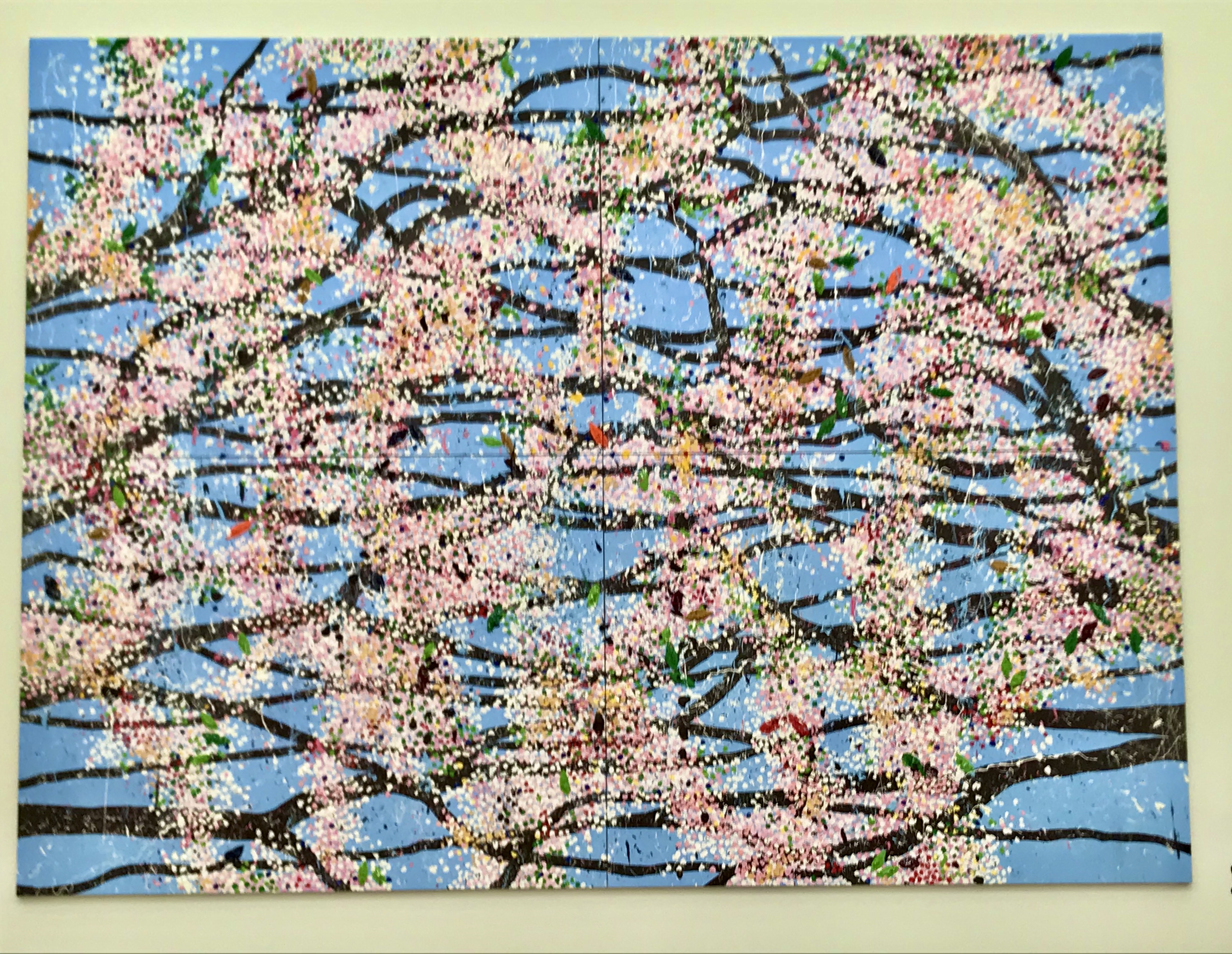Floral Expressions of Life and Death
Damien Hirst in his studio, 2019, Photographed by Prudence Cuming Associates Ltd, © Damien Hirst and Science Ltd. All rights reserved, DACS 2022
There could be no more perfect way to celebrate spring than by visiting Damien Hirst’s Cherry Blossoms at The National Art Center, Tokyo through May 23rd. Entering the spacious exhibit, one is mesmerized by 24 huge paintings, many measuring over three meters high and about two meters wide. They gleam with sprawling cherry blossom trees, dotted abstractly in rhythmic shades of pink, red, green, gold, and white.

Damien Steven Hirst is one of England’s most successful artists, entrepreneurs, and art collectors, having dominated the art scene in the UK during the 1980s and 1990s. He is famed for his “spin paintings,” which he created by pouring gloss paint onto a mechanically rotating canvas, and for his “spot paintings" featuring rows of randomly colored circles. In the 1980s, he was a founding member of Young British Artists (YBAs), which abandoned traditional methods of art and instead dealt with experimental and radical themes, to the point of provoking shock. Hirst has been known to emphasize death as a subject and has produced works involving animal carcasses, either preserved or dissected. The Physical Impossibility of Death In The Mind of Someone Living (1991), displaying a monstrous 4.3-meter tiger shark suspended in formaldehyde in a glass case, became emblematic of Hirst’s art. It typified his interpretation of conceptual postmodernism, particularly the symbiotic relationship between life and death.
It is quite intriguing, therefore, that an artist prominently linked with expressions of death, depression, and darkness would embark on an uplifting series depicting flower blossoms. Hirst recalls the catalyst for this transition, which emerged from his series Veil Paintings in 2019. “I was trying to get a depth…where you could not look at them, but through them…I kind of realized it looked like a garden of trees. Then, I just started thinking about abstraction and figuration. If they managed to remain abstract and look figurative, they could bring those two worlds. Then, I remembered my mum’s cherry blossoms and thought…I could just do cherry blossoms.” (From an interview by art historian Tim Marlow)

In 2019, Hervé Chandès, general director of the Fondation Cartier, met Hirst for the first time in his London studio. Immediately, he was enthralled by an “impression of joyful intoxication, captivated by the beauty, colors, and excess matter” in the radiant cherry blossoms. Hirst was invited to publicly present 30 pieces from his series of 107 large-scale paintings at the Fondation Cartier in Paris in 2021. The vast canvases saturated with erupting buds were divided into single panels, diptychs, triptychs, and so on. The show was a tremendous success, receiving much attention from audiences who sought promise of a return to regular life amid the harsh realities of the pandemic. This year the exhibition moved to The National Art Center, Tokyo, marking the artist’s first major solo show in Japan.

The seasonal celebration of cherry blossoms is a centuries-old custom in Japan, woven culturally and philosophically into the lives of the Japanese people. In contrast with many Japanese painters’ soft and realistic-looking portrayals of the national flower’s petals, Hirst’s renderings are explosive and somewhat lurid, bursting with thick brushstrokes and marked by Impressionism and Pointillism. And yet, the loud tints of pink and red settle pleasantly against a pacifying blue background, creating an ambience of joviality and fantasy.
Hirst summarizes, “They’re extreme…they’re decorative but taken from nature. They’re about desire and how we process the things around us and what we turn them into, but also about the insane visual transience of beauty—a tree in full crazy blossom against a clear sky…They’re garish and messy and fragile and about me moving away from Minimalism and the idea of an imaginary mechanical painter and that’s so exciting for me.”

Casting an eye over the canvases, at first the compositions appear to repeat. However, with close scrutiny, one can detect how each painting differs in the volume of petals, the thickness of brushstrokes, the bend of branches, the spaces between buds, and the depth of colors. The triptych Sakura Life Blossoms (2019) is a bewitching portrait of brightly hued red, pink, and white blossoms. The deep brown branches, providing color contrast, stretch out in multiple directions, breathing vitality. Early Blossom (2018) stands out for its striking pinks and reds covering the entire picture. The largest in scale – measuring over five meters high and seven meters long – Greater Love Has No-One Than This Blossom (2019) hypnotizes with its intertwined branches and frolicking flowers.
Hirst wanted to paint gigantic trees so that the viewer has a sense of almost falling into them. He intended for the blossoms to reach out aggressively, provoking a physical reaction. To him, cherry blossoms are “the most poetic illustrations of the passing of time.”
Alma Reyes
Alma Reyes



